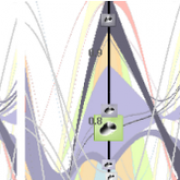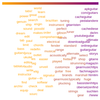Knowledge workers, such as scientists, journalists, or consultants, adaptively seek, gather, and consume information. Initially, knowledge workers may not even know what exactly they are looking for. Only after investigating more and more information, they develop a more concrete mental picture. These “information foraging” and “sensemaking” processes are often inefficient as existing user interfaces provide limited possibilities to combine information from various sources and different formats into a common knowledge representation. The goal of this project was to facilitate such knowledge-intensive tasks through user interfaces that combine manual organization strategies, such as piling of papers and text annotations, with powerful automatic data processing to reveal hidden relations in the collected data.
This project led to multiple novel user interface concepts that support knowledge-intensive tasks. For instance, visual query expansion is an extension to a search engine that visualizes the effects of suggested variations on an online query result to help users to refine their query terms. The information collage lets users capture information fragments from any online sources, which can then be freely recomposed into a common knowledge representation. Natural language processing helps users to identify common topics in their collage. BiCFlows helps users to discover hidden relations in very large information collections. For instance, they can explore which authors tend to contribute to similar topics.
The user interfaces served as foundation for empirical research with users from different knowledge work domains. This research provided new insights into the strengths but also the limitations of interactive visualization for information foraging and sensemaking. On the one hand, the studies show that, in some situations, interactive visualization can be less efficient than working with unprocessed text-based information. On the other hand, the studies also show that combining automatic data analysis with interactive visualization can lead to more unexpected findings, especially when exploring large data. The extent of manual information organization varies with the task: the less users know about the gathered information, the more automatic organization they expect.
In summary, this project contributed novel user interface concepts and design guidelines for user interfaces supporting information foraging and sensemaking. The techniques and study results were published at high-ranking peer-reviewed venues, and it can be expected that the findings of this project shape the way how users seek and organize their information in the future.
Funding
- FWF T 752-N30
Research Areas
- In this research area, our focus lies on novel visual encodings and interaction techniques to explore a large amount of abstract data, often in combination with analytical reasoning.
Publications
33 Publications found:
|◀
◀
Results 1 - 33 of 33
⚙
▶
▶|
Download list as Bibtex, HTML (Advanced, Expert), JSON (with referenced objects), CSV, Permalink




 image
image Master thesis
Master thesis Poster
Poster
 paper
paper
 video
video
 video
video

 paper
paper video
video


 CESCG paper
CESCG paper

 image
image Poster
Poster

 paper
paper
 paper
paper video
video
 Master Thesis
Master Thesis Poster
Poster sketch
sketch
 image
image Master thesis
Master thesis


 paper
paper
 paper
paper paper
paper
 paper
paper





 paper
paper
